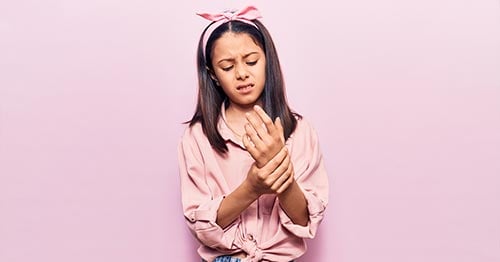Juvenile Idiopathic Arthritis
What is juvenile idiopathic arthritis?
Juvenile idiopathic arthritis (JIA) – formerly also called juvenile rheumatoid arthritis (JRA) or juvenile chronic arthritis (JCA) – is defined as joint inflammation lasting more than six weeks in a child or adolescent younger than 16 years of age.
People are often surprised that children can have arthritis. In fact, JIA is the most common rheumatic disease in children and the cause of a significant amount of short term and long-term disability. About 1 to 20 per 100,000 children have JIA. This condition affects children of all ages, from toddlers to teenagers. There are multiple subtypes of JIA, and about 10% to 15% of patients with this condition have a rare form called systemic juvenile idiopathic arthritis (formerly known as Still's disease).
What causes juvenile idiopathic arthritis?
"Idiopathic" means "unknown cause," and the exact cause of JIA is not known, though there is a lot of research being done on this subject. All types of JIA are thought to be due to a combination of genetic and environmental factors. JIA is considered a chronic condition, meaning that these symptoms may last for a long time, and sometimes continue into adulthood. There are several different types of JIA, which are based on the number of joints with arthritis, the types of joints affected, and other symptoms your child or teenager may have. These types include:
- oligoarticular JIA – four or fewer joints with arthritis
- polyarticular JIA – five or more joints with arthritis
- psoriatic arthritis – a form of spondyloarthritis associated with psoriasis in the child or that of a close family member
- enthesitis-related arthritis (ERA) – a form of spondyloarthritis which also involves the areas where the ligaments or tendons attach to the bones
- Systemic juvenile idiopathic arthritis (SJIA) – a systemic disease where patients develop fevers, rashes, and issues with the internal organs in addition to arthritis. Though systemic JIA is considered a type of juvenile idiopathic arthritis, it is very different from the other four subtypes
What are the symptoms of juvenile idiopathic arthritis?
Children with arthritis may experience a wide variety of symptoms. Children may develop pain, swelling, stiffness or warmth in their joints. Frequently, younger children may not complain of pain at all, but they may develop a limp or have difficulty using their fingers.
Joint symptoms are typically worse first thing in the morning or after a period of rest, and then improve throughout the day as the child becomes more active. Children with oligoarticular JIA usually have involvement of larger joints such as the knees or ankles, while those with psoriatic or polyarticular JIA may also have involvement of small joints, such as the fingers and toes, and joints of the pelvis or spine. Because arthritis is associated with inflammation, the child may feel tired, have a decrease in appetite, or have slow growth. JIA can also be associated with eye disease such as uveitis, which may cause vision loss if untreated.
(Children who have the rarer, systemic form of this disease may also experience rashes, fevers and complications affecting different organs. Read more about these on our [NEW LINK] systemic juvenile idiopathic arthritis page.)
How is a child diagnosed with juvenile idiopathic arthritis?
There is no one specific test to diagnose juvenile idiopathic arthritis. Imaging and laboratory studies may be used to support a diagnosis in a child who has symptoms of arthritis, and to help rule out other underlying causes. Lab tests may reveal elevated inflammatory markers and anemia, as well as certain antibodies, including antinuclear antibody (ANA), rheumatoid factor (RF), and citric citrullinated peptide (CCP). Certain genetic markers, such as HLA-B27, are also associated with JIA. Some children have JIA with no positive antibodies or genetic markers.
To rule out infection, a doctor may order blood or joint fluid tests for Lyme disease antibodies or those of other conditions. Imaging studies such as X-ray, ultrasound and MRI, may be ordered to look for inflammation and damage to the joints. All children with a suspected diagnosis of JIA should be seen by an ophthalmologist to rule out uveitis.
How is juvenile idiopathic arthritis treated?
Treatment depends on the type and severity of the arthritis in addition to factors specific to the child and family. Commonly, therapies involve a combination of medications and physical or occupational therapy. The main goals of treating arthritis in children are to decrease joint pain and stiffness, control inflammation, and maximize growth and function.
- Medications that may be used include NSAIDs (nonsteroidal anti-inflammatory drugs), disease-modifying antirheumatic drugs (DMARDs), biologic medications, and injection of steroids directly into the affected joint(s).
- Physical and occupational therapy are crucial for restoring mobility and joint function. Children with JIA have the best prognosis when they have a multidisciplinary healthcare team that includes their parents, teachers, pediatric rheumatologist, ophthalmologist, and physical and occupational therapists.
Should a child who has JIA see a rheumatologist?
Juvenile idiopathic arthritis is a chronic condition, and careful monitoring by a pediatric rheumatologist is recommended into adulthood. Prompt recognition and treatment of joint inflammation or limitation can help prevent pain and long-term damage. It was previously thought that children may “outgrow” arthritis. It is now recognized that most children have joint disease that persists. (Find a specialist at HSS who treats juvenile arthritis.)
Children with JIA also need continued ophthalmology monitoring for uveitis. The frequency of eye exams will depend on your child’s age, how long they have had arthritis, and whether they test positive for the ANA antibody.
Depending on your child’s symptoms, additional follow-up may be needed by other medical specialties.
The long-term prognosis for children with JIA has improved dramatically since the introduction of newer medications. Early recognition of disease, regular follow up and appropriate therapy will help to optimize functional outcomes.
Outside resources for families: Arthritis Foundation | Kids Get Arthritis Too | PRINTO


